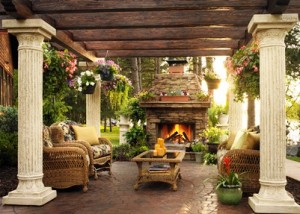Container plantings are a great way to add blooms and foliage to your yard without needing to put in garden beds. Containers also provide versatility in arrangement, since they are movable. For instance, large pots let you bring flowers into your outdoor kitchen or patio and hanging containers add color and beauty to a pergola or deck roof. But care for plants in containers is a little different than for those put in the ground.
 Flowers in container planters do better the bigger the container. Plants in large containers have healthier root systems, need less watering, and will produce more flowers and healthier greenery. Window box plantings typically have shallower depths that will cause plants to dry out faster as opposed to those in a deeper container. This can be a problem that is solved by filling window boxes with plants that need less water. Some of those plants include geraniums, scaevola, ivies, grasses, and osterosperum.
Flowers in container planters do better the bigger the container. Plants in large containers have healthier root systems, need less watering, and will produce more flowers and healthier greenery. Window box plantings typically have shallower depths that will cause plants to dry out faster as opposed to those in a deeper container. This can be a problem that is solved by filling window boxes with plants that need less water. Some of those plants include geraniums, scaevola, ivies, grasses, and osterosperum.
When planting a pot, choose plants that have similar needs and wants. This isn’t the time to mix shade- and sun-loving plants. Place the plants in the new container at the same depth as they were in the pots they came in. Pay attention to the amount of space the plants need; overcrowding will make for unhealthy plants as they grow and fill out.
Good watering is key. The best indication that a plant needs watering is when the potting soil right below the surface feels dry. When the weather is hotter this could mean that a plant needs water everyday. The correct way to water plants is to gently drench a pot until a trickle of water comes out of the drain hole. It’s important not to let plants get too dry as they will wilt, delay their flowering, and ultimately die. If there is too much water, the roots can rot, or the rootlets can shut down and not take any more water.
Fertilizing container plants is also very important. Plants need nutrients from the soil; their roots break down the minerals found in the soil. Containers – because they are watered often – tend to have the nutrients leached out of the soil and need to be re-fed more often than garden beds. There are two types of nutrients that can be added: time-release and water-soluble fertilizers. Time-release fertilizer need heat to react, not water. A recommendation is to feed containers with time-release fertilizer when you initially add your plants, and then fertilize weekly with water-soluble fertilizer for the best blooming healthy plants.
Container plantings can add color to your landscape in places where a garden bed won’t work. At ALD we often incorporate container-grown flowers and foliage to accent outdoor rooms, decks, and entry areas.
